Journal Description
Actuators
Actuators
is an international, peer-reviewed, open access journal on the science and technology of actuators and control systems published monthly online by MDPI.
- Open Access— free for readers, with article processing charges (APC) paid by authors or their institutions.
- High Visibility: indexed within SCIE (Web of Science), Scopus, Inspec, and other databases.
- Journal Rank: JCR - Q2 (Engineering, Mechanical) / CiteScore - Q1 (Control and Optimization)
- Rapid Publication: manuscripts are peer-reviewed and a first decision is provided to authors approximately 19 days after submission; acceptance to publication is undertaken in 1.9 days (median values for papers published in this journal in the first half of 2025).
- Recognition of Reviewers: reviewers who provide timely, thorough peer-review reports receive vouchers entitling them to a discount on the APC of their next publication in any MDPI journal, in appreciation of the work done.
- Journal Cluster of Instruments and Instrumentation: Actuators, AI Sensors, Instruments, Micromachines and Sensors.
Impact Factor:
2.3 (2024);
5-Year Impact Factor:
2.4 (2024)
Latest Articles
A Study on Compensation for Operating Region Variations in an In-Wheel PMSM Under Temperature Changes Using Neural Network Algorithms
Actuators 2025, 14(10), 508; https://doi.org/10.3390/act14100508 (registering DOI) - 20 Oct 2025
Abstract
This study proposes a compensation method for operating region variations in in-wheel PMSMs, which are widely used in small mobility applications such as e-scooters and e-bikes. As motor temperature increases during operation, electrical parameters such as inductance vary, leading to unstable control. To
[...] Read more.
This study proposes a compensation method for operating region variations in in-wheel PMSMs, which are widely used in small mobility applications such as e-scooters and e-bikes. As motor temperature increases during operation, electrical parameters such as inductance vary, leading to unstable control. To address this, a Single-Layer Backpropagation Neural Network (SLBPNN) is used to estimate inductance variations in real-time. The proposed algorithm adjusts the motor’s operating point to maintain stable performance under thermal stress. Simulation results using MATLAB 2024b confirm the model’s effectiveness by estimating inductance from voltage, current, speed, and position inputs. Experimental validation further demonstrates that the proposed method compensates for the shift in the operating region due to temperature changes, improving the overall motor efficiency.
Full article
(This article belongs to the Special Issue Power Electronics and Actuators—Second Edition)
►
Show Figures
Open AccessArticle
MEC-Based Modeling and Design of Permanent Magnet Synchronous Machines with Axial–Radial Rotor Extensions Using Yoke and Rotor-Side Spaces
by
Soheil Yousefnejad, Majid Mehrasa and Parviz Rastgoufard
Actuators 2025, 14(10), 507; https://doi.org/10.3390/act14100507 (registering DOI) - 20 Oct 2025
Abstract
This paper proposes a solution to enhance the torque production capability of Permanent Magnet Synchronous Machine (PMSM), utilizing not only the unused space resulting from the stator end windings on the rotor side, but also the otherwise unused space around the winding on
[...] Read more.
This paper proposes a solution to enhance the torque production capability of Permanent Magnet Synchronous Machine (PMSM), utilizing not only the unused space resulting from the stator end windings on the rotor side, but also the otherwise unused space around the winding on the yoke side. By implementing an additional axial rotor equipped with Permanent Magnets (PMs) in both rotor and yoke sides, the proposed design technique increases the PMSM torque output, taking advantage of the useless space on the yoke side. In the proposed configuration, one magnetic flux path circulates between the PMs on the rotor (rotor side) and the stator, while an additional flux path circulates between the PMs positioned on both sides of the stator end windings. These two flux paths contribute to generating a stronger and more effective magnetic field within the machine than conventional structure, resulting in increased torque density. A magnetic equivalent circuit (MEC) model of the proposed design is developed, and its accuracy is validated through Finite Element (FE) analysis. For a fair evaluation, the proposed structure is compared with a conventional configuration using the same volume of PM material. Furthermore, optimization of the proposed design is carried out to maximize Torque/PM.
Full article
(This article belongs to the Special Issue Next-Generation Electric Machine Design and Control for Sustainable Mobility)
►▼
Show Figures
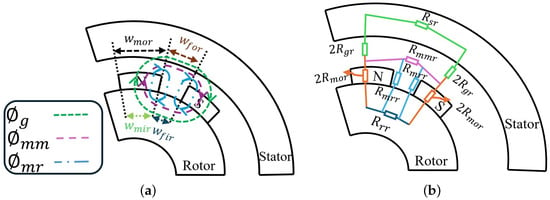
Figure 1
Open AccessArticle
Integral Reinforcement Learning-Based Stochastic Guaranteed Cost Control for Time-Varying Systems with Asymmetric Saturation Actuators
by
Yuling Liang, Mengjia Xie, Juan Zhang, Zhongyang Ming and Zhiyun Gao
Actuators 2025, 14(10), 506; https://doi.org/10.3390/act14100506 (registering DOI) - 19 Oct 2025
Abstract
This study explores a stochastic guarantee cost control (GCC) for time-varying systems with random parameters and asymmetric saturation actuators by employing the integral reinforcement learning (IRL) method in the dynamic event-triggered (DET) mode. Firstly, a modified Hamilton–Jacobi–Isaac (HJI) equation is formulated, and then
[...] Read more.
This study explores a stochastic guarantee cost control (GCC) for time-varying systems with random parameters and asymmetric saturation actuators by employing the integral reinforcement learning (IRL) method in the dynamic event-triggered (DET) mode. Firstly, a modified Hamilton–Jacobi–Isaac (HJI) equation is formulated, and then the worst-case disturbance policy and the asymmetric saturation optimal control signal can be obtained. Secondly, the multivariate probabilistic collocation method (MPCM) is used to evaluate the value function at designated sampling points. The purpose of introducing the MPCM is to simplify the computational complexity of stochastic dynamic programming (SDP) methods. Furthermore, the DET mode is utilized to solve the SDP problem to reduce the computational burden on communication resources. Finally, the Lyapunov stability theorem is applied to analyze the stability of time-varying systems, and the simulation shows the feasibility of the designed method.
Full article
(This article belongs to the Special Issue Advances in Intelligent Control of Actuator Systems)
Open AccessArticle
Velocity Trajectory Planning and Tracking Control Based on Basis Function Superposition and Metaheuristic Algorithms for Planar Underactuated Manipulators
by
Ba Zeng, Yang Li, Xiangyu Gong, Hongwei Wang, Zixin Huang and Hongjian Zhou
Actuators 2025, 14(10), 505; https://doi.org/10.3390/act14100505 (registering DOI) - 18 Oct 2025
Abstract
Planar underactuated manipulators are widely used in aerospace and deep-sea exploration. Due to their passive joints without actuation, it is difficult to perform trajectory planning and direct control. In this paper, an angular velocity trajectory planning method is proposed, aiming to calculate the
[...] Read more.
Planar underactuated manipulators are widely used in aerospace and deep-sea exploration. Due to their passive joints without actuation, it is difficult to perform trajectory planning and direct control. In this paper, an angular velocity trajectory planning method is proposed, aiming to calculate the velocity trajectory by using a superposition of basis functions and transforming the planning problem into an optimization problem by using a metaheuristic algorithm. According to the underactuated constraint relationship, the planning trajectory of the passive joint is obtained, which ensures that the passive joint can be indirectly controlled to reach the target angle while tracking the trajectory of the active joint. For the tracking control problem, a sliding mode controller with an exponential convergence rate is used to track the trajectory. Lastly, three sets of simulations are run to demonstrate the efficacy of the suggested approach.
Full article
(This article belongs to the Section Actuators for Robotics)
Open AccessArticle
Decoupling-Free Attitude Control of UAV Considering High-Frequency Disturbances: A Modified Linear Active Disturbance Rejection Method
by
Changjin Dong, Yan Huo, Nanmu Hui, Xiaowei Han, Binbin Tu, Zehao Wang and Jiaying Zhang
Actuators 2025, 14(10), 504; https://doi.org/10.3390/act14100504 (registering DOI) - 18 Oct 2025
Abstract
With the rapid development of unmanned aerial vehicle (UAV) technology, quadrotor UAVs have demonstrated extensive application potential in various fields. However, due to parameter uncertainties and strong coupling, the flight attitude of quadrotors is prone to external disturbances, posing challenges for achieving precise
[...] Read more.
With the rapid development of unmanned aerial vehicle (UAV) technology, quadrotor UAVs have demonstrated extensive application potential in various fields. However, due to parameter uncertainties and strong coupling, the flight attitude of quadrotors is prone to external disturbances, posing challenges for achieving precise control and stable flight. In this paper, we address the tracking control problem under unknown command rate variations by proposing a Modified Linear Active Disturbance Rejection Control (LADRC) strategy, aiming to enhance flight stability and anti-disturbance capability in complex environments. First, based on the attitude dynamics model of quadrotors, an LADRC technique is adopted to realize three-channel decoupling-free control. By integrating a parameter estimator, the proposed method can compensate unknown disturbances in real time, thereby improving the system’s anti-disturbance ability and dynamic response performance. Second, to further enhance system robustness, a linear extended state observer (LESO) is designed to accurately estimate the tracking error rate and total disturbances. Additionally, a Levant differentiator is introduced to replace the traditional differentiation component for optimizing the response speed of command rate. Finally, a modified LADRC controller incorporating error rate estimation is constructed. Simulation results validate that the proposed scheme maintains good tracking accuracy under high-frequency disturbances, providing an effective solution for stable UAV flight in complex scenarios. Compared with traditional control methods, the modified LADRC strategy exhibits significant advantages in tracking performance, anti-disturbance capability, and dynamic response. This research not only offers a novel perspective and solution for quadrotor control problems but also holds important implications for improving UAV performance and reliability in practical applications.
Full article
(This article belongs to the Section Control Systems)
►▼
Show Figures
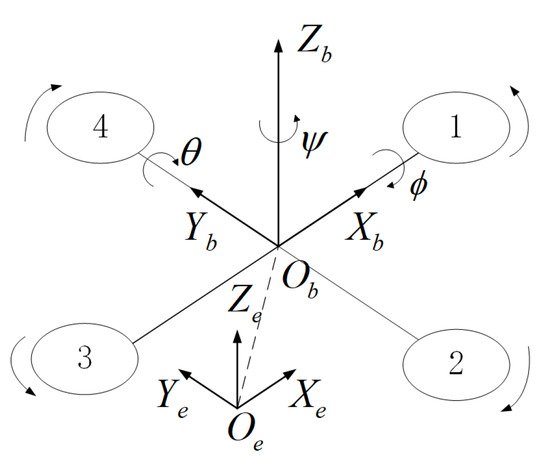
Figure 1
Open AccessArticle
Robust Sliding-Mode Control of a Two-DOF Lower-Limb Exoskeleton Using a Cascade-Adaptive Super-Twisting Observer
by
Sahbi Boubaker, Habib Dimassi, Salim Hadj Said and Souad Kamel
Actuators 2025, 14(10), 503; https://doi.org/10.3390/act14100503 (registering DOI) - 18 Oct 2025
Abstract
This paper presents an output-feedback sliding-mode control strategy for a two-DOF lower-limb exoskeleton system aimed at rehabilitation assistance for disabled individuals. The core of the approach is a cascade super-twisting observer, beginning with a super-twisting differentiator (STD) that estimates unmeasured angular velocities from
[...] Read more.
This paper presents an output-feedback sliding-mode control strategy for a two-DOF lower-limb exoskeleton system aimed at rehabilitation assistance for disabled individuals. The core of the approach is a cascade super-twisting observer, beginning with a super-twisting differentiator (STD) that estimates unmeasured angular velocities from measured joint angles. These velocity estimates feed into a second-stage adaptive super-twisting sliding-mode observer (ASTSMO), which accurately reconstructs external load torque disturbances affecting the system. Using these estimates, a sliding-mode controller robustly tracks the exoskeleton’s desired trajectories despite external disturbances. The stability of the proposed control scheme is rigorously established through Lyapunov-based analysis within a sliding-mode framework. Numerical simulations conducted in Matlab R2022/Simulink demonstrate the method’s effectiveness in accurately estimating unmeasured states and unknown disturbances, as well as achieving robust tracking performance in the presence of system uncertainties.
Full article
(This article belongs to the Section Actuators for Robotics)
Open AccessReview
Stapes Prostheses in Otosclerosis Surgery: Materials, Design Innovations, and Future Perspectives
by
Luana-Maria Gherasie, Viorel Zainea, Razvan Hainarosie, Andreea Rusescu, Irina-Gabriela Ionita, Ruxandra-Oana Alius and Catalina Voiosu
Actuators 2025, 14(10), 502; https://doi.org/10.3390/act14100502 - 17 Oct 2025
Abstract
Background: Stapes prostheses represent one of the earliest and most widely applied “biomedical actuators” designed to restore hearing in patients with otosclerosis. Unlike conventional actuators, which convert energy into motion, stapes prostheses function as passive or smart micro-actuators, transmitting and modulating acoustic
[...] Read more.
Background: Stapes prostheses represent one of the earliest and most widely applied “biomedical actuators” designed to restore hearing in patients with otosclerosis. Unlike conventional actuators, which convert energy into motion, stapes prostheses function as passive or smart micro-actuators, transmitting and modulating acoustic energy through the ossicular chain. Objective: This paper provides a comprehensive analysis of stapes prostheses from an engineering and biomedical perspective, emphasizing design principles, materials science, and recent innovations in smart actuators based on shape-memory alloys combined with surgical applicability. Methods: A narrative review of the evolution of stapes prostheses was consolidated by institutional surgical experience. Comparative evaluation focused on materials (Teflon, Fluoroplastic, Titanium, Nitinol) and design solutions (manual crimping, clip-on, heat-activated prostheses). Special attention was given to endoscopic stapes surgery, which highlights the ergonomic and functional requirements of new device designs. Results: Traditional fluoroplastic and titanium pistons provide reliable sound conduction but require manual crimping, with a higher risk of incus necrosis and displacement. Innovative prostheses, particularly those manufactured from nitinol, act as self-crimping actuators activated by heat, improving coupling precision and reducing surgical trauma. Emerging designs, including bucket-handle and malleus pistons, expand applicability to complex or revision cases. Advances in additive manufacturing and middle ear cement fixation offer opportunities for customized, patient-specific actuators. Conclusions: Stapes prostheses have evolved from simple passive pistons to innovative biomedical actuators exploiting shape-memory and biocompatible materials. Future developments in stapes prosthesis design are closely linked to 3D printing technologies. These developments have the potential to enhance acoustic performance, durability, and patient outcomes, thereby bridging the gap between otologic surgery and biomedical engineering.
Full article
(This article belongs to the Section Actuators for Medical Instruments)
►▼
Show Figures

Figure 1
Open AccessArticle
Design and Implementation of Decoupling Controllers for Vertical Suspension System of Magnetic Suspension and Balance System
by
Xu Zhou, Wentao Xia, Fengshan Dou and Zhiqiang Long
Actuators 2025, 14(10), 501; https://doi.org/10.3390/act14100501 - 16 Oct 2025
Abstract
The Magnetic Suspension Balance System (MSBS) serves as a core apparatus for interference-free aerodynamic testing in wind tunnels, where its high-precision levitation control performance directly determines the reliability of aerodynamic force measurements. This paper addresses the strong coupling issues induced by rigid-body motion
[...] Read more.
The Magnetic Suspension Balance System (MSBS) serves as a core apparatus for interference-free aerodynamic testing in wind tunnels, where its high-precision levitation control performance directly determines the reliability of aerodynamic force measurements. This paper addresses the strong coupling issues induced by rigid-body motion in the MSBS vertical suspension system and proposes a decoupling control framework integrating classical decoupling methods with geometric feature transformation. First, a nonlinear dynamic model of the six-degree-of-freedom MSBS is established. Through linearization analysis of the vertical suspension system, the intrinsic mechanism of displacement-pitch coupling is revealed. Building upon this foundation, a state feedback decoupling controller is designed to achieve decoupling among dynamic channels. Simulation results demonstrate favorable control performance under ideal linear conditions. To further overcome its dependency on model parameters, a decoupling strategy based on geometric feature transformation is proposed, which significantly enhances system robustness in nonlinear operating conditions through state-space reconstruction. Finally, the effectiveness of the proposed method in vertical suspension control is validated through both numerical simulations and a physical MSBS experimental platform.
Full article
(This article belongs to the Special Issue Advanced Theory and Application of Magnetic Actuators—3rd Edition)
►▼
Show Figures

Figure 1
Open AccessArticle
In-Situ Validation and Performance Analysis of Polymer-Dispersed Liquid Crystal Films for Dynamic Natural Light Control in Smart Greenhouses
by
Chiara Vetter, Peyton I. Mann and Alexander H. Pesch
Actuators 2025, 14(10), 500; https://doi.org/10.3390/act14100500 - 15 Oct 2025
Abstract
Polymer-Dispersed Liquid Crystal (PDLC) films offer a promising actuation method for dynamically controlling natural light, particularly in applications like smart greenhouses that require optimized Photosynthetically Active Radiation (PAR). Building upon previous work that established a control-oriented model and validated it under laboratory conditions,
[...] Read more.
Polymer-Dispersed Liquid Crystal (PDLC) films offer a promising actuation method for dynamically controlling natural light, particularly in applications like smart greenhouses that require optimized Photosynthetically Active Radiation (PAR). Building upon previous work that established a control-oriented model and validated it under laboratory conditions, this study presents significant extensions. Key novel contributions include (1) the design and implementation of a Mini Greenhouse (MGH) test rig featuring PDLC films angled at 45° to accommodate typical sun angles; (2) extensive in situ validation of the previously developed Proportional–Integral (PI) control scheme under real-world environmental conditions, including varying natural sunlight, cloud cover, rain, and snow over several weeks; (3) analysis of system performance at different PAR setpoints (4 PAR and 10.5 PAR) under these conditions; (4) characterization of the system’s controllable PAR range and transmittance under natural light; (5) calculation of a light reduction ratio attributable to the MGH structure for accurate disturbance modeling; and (6) validation of an extended simulation model using the collected in situ data. The results demonstrate the system’s capability to effectively track setpoints and reject disturbances under dynamic natural light, confirming the robustness of the PDLC control approach. The validated simulation provides a reliable tool for predicting performance and optimizing control strategies for energy-efficient smart greenhouse applications. This work significantly advances the practical assessment of PDLC actuators for agricultural light management beyond laboratory settings.
Full article
(This article belongs to the Section Control Systems)
►▼
Show Figures
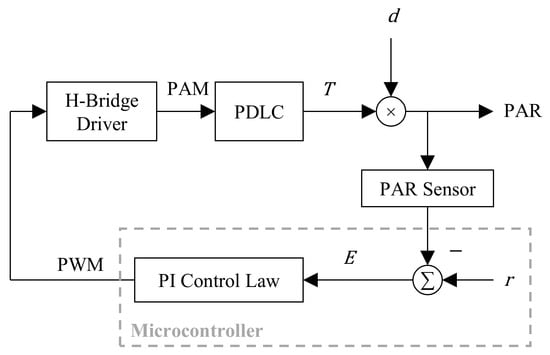
Figure 1
Open AccessArticle
Numerical Investigation of a Morphing Wing Section Controlled by Piezoelectric Patches
by
Mario Rosario Chiarelli, Vincenzo Binante, Salvatore Bonomo, Stefano Botturi, Luca Giani, Jan Kunzmann, Aniello Cozzolino and Diego Giuseppe Romano
Actuators 2025, 14(10), 499; https://doi.org/10.3390/act14100499 - 15 Oct 2025
Abstract
One of the tasks of the FutureWings project, funded by the European Commission within the 7th framework, was to numerically validate the mechanical behavior of a wing whose deflections had to be controlled via a suitable distribution of piezoelectric patches. Starting from a
[...] Read more.
One of the tasks of the FutureWings project, funded by the European Commission within the 7th framework, was to numerically validate the mechanical behavior of a wing whose deflections had to be controlled via a suitable distribution of piezoelectric patches. Starting from a reference geometry (a NACA 0012 airfoil), wing profiles were implemented and analyzed using the fluid–structure interaction analysis technique. The wing section was designed with a morphing profile in which both the front and rear parts self-deform via piezoelectric patches that serve actuators glued to the skin of the profile. A Macro Fiber Composite (MFC) was used as the piezoelectric actuator. Aeroelastic analyses were performed at low Mach numbers under the sea-level flight condition. Analysis of the technical solution was based on an examination of the aerodynamic coefficients and polar curves of the profile, as the control voltage of the patches can vary. The results were compared with those available in the literature. As a preliminary step, this work contributes to examining the current technical possibilities of this technology relating to the application of piezoelectric patches as actuators in the field of aerostructures.
Full article
(This article belongs to the Special Issue Aerospace Mechanisms and Actuation—Second Edition)
►▼
Show Figures

Figure 1
Open AccessArticle
Optimization and Experimental Investigation of a Single-Actuation Compliant Morphing Trailing Edge for Multiple Aerodynamic Configurations
by
Martynas Lendraitis and Vaidas Lukoševičius
Actuators 2025, 14(10), 498; https://doi.org/10.3390/act14100498 - 15 Oct 2025
Abstract
This work presents a low-fidelity optimization method for a compliant morphing wing trailing-edge structure, developed to achieve multiple optimized aerodynamic shapes under combined aerodynamic and control loads using a single actuation pathway. Typically, multiple shape configurations are avoided due to conflicting structural requirements
[...] Read more.
This work presents a low-fidelity optimization method for a compliant morphing wing trailing-edge structure, developed to achieve multiple optimized aerodynamic shapes under combined aerodynamic and control loads using a single actuation pathway. Typically, multiple shape configurations are avoided due to conflicting structural requirements that increase optimization complexity. To address this, a parameterization method based on practical considerations of compliant trailing-edge structures is introduced. A particle swarm optimization algorithm is employed, with multi-objective criteria handled through a penalty-based approach. The algorithm is demonstrated by optimizing the trailing edge for one and two aerodynamic configurations with high accuracy, achieving typical shape deviations of 0.04% and 0.08% relative to the chord for two shapes, and as low as 0.023% for a single shape. Several compliant structures are generated, manufactured, and tested for shape accuracy, including in a wind tunnel to evaluate aerodynamic performance. Experimental investigations confirm the feasibility of achieving two aerodynamic shape configurations with a single structure and show that the proposed methodology can improve the lift-to-drag ratio of a wing section with a deflected compliant trailing edge by more than 12.4% compared to conventional flaps at the same deflection.
Full article
(This article belongs to the Special Issue Aerospace Mechanisms and Actuation—Second Edition)
►▼
Show Figures

Figure 1
Open AccessArticle
Dynamic Parameter Identification Method for Space Manipulators Based on Hybrid Optimization Strategy
by
Haitao Jing, Xiaolong Ma, Meng Chen and Jinbao Chen
Actuators 2025, 14(10), 497; https://doi.org/10.3390/act14100497 - 15 Oct 2025
Abstract
High-precision identification of dynamic parameters is crucial for the on-orbit performance of space manipulators. This paper investigates dynamic modeling and parameter identification under special environmental conditions such as microgravity and vacuum. First, a dynamic model of the manipulator incorporating a nonlinear friction term
[...] Read more.
High-precision identification of dynamic parameters is crucial for the on-orbit performance of space manipulators. This paper investigates dynamic modeling and parameter identification under special environmental conditions such as microgravity and vacuum. First, a dynamic model of the manipulator incorporating a nonlinear friction term is established using the Newton-Euler method, and an improved Stribeck friction model is proposed to better characterize high-speed conditions and space environmental effects. On this basis, a hybrid parameter identification method combining Particle Swarm Optimization (PSO) and Levenberg–Marquardt (LM) algorithms is proposed to balance global search capability and local convergence accuracy. To enhance identification performance, Fourier series are used to design excitation trajectories, and their harmonic components are optimized to improve the condition number of the observation matrix. Experiments conducted on a ground test platform with a six-degree-of-freedom (6-DOF) manipulator show that the proposed method effectively identifies 108 dynamic parameters. The correlation coefficients between predicted and measured joint torques all exceed 0.97, with root mean square errors below 5.1 N·m, demonstrating the high accuracy and robustness of the method under limited data samples. The results provide a reliable model foundation for high-precision control of space manipulators.
Full article
(This article belongs to the Special Issue Dynamics and Control of Aerospace Systems—2nd Edition)
►▼
Show Figures

Figure 1
Open AccessArticle
Observer-Based Volumetric Flow Control in Nonlinear Electro-Pneumatic Extrusion Actuator with Rheological Dynamics
by
Ratchatin Chancharoen, Chaiwuth Sithiwichankit, Kantawatchr Chaiprabha, Setthibhak Suthithanakom and Gridsada Phanomchoeng
Actuators 2025, 14(10), 496; https://doi.org/10.3390/act14100496 - 14 Oct 2025
Abstract
►▼
Show Figures
Consistent volumetric flow control is essential in extrusion-based additive manufacturing, particularly when printing viscoelastic materials with complex rheological properties. This study proposes a control framework incorporating simplified rheological dynamics via a Kelvin–Voigt model that integrates nonlinear dynamic modeling, an unknown input observer (UIO),
[...] Read more.
Consistent volumetric flow control is essential in extrusion-based additive manufacturing, particularly when printing viscoelastic materials with complex rheological properties. This study proposes a control framework incorporating simplified rheological dynamics via a Kelvin–Voigt model that integrates nonlinear dynamic modeling, an unknown input observer (UIO), and a closed-loop PID controller to regulate material flow in a motorized electro-pneumatic extrusion system. A comprehensive state-space model is developed, capturing both mechanical and rheological dynamics. The UIO estimates unmeasurable internal states—specifically, syringe plunger velocity—which are critical for real-time flow regulation. Simulation results validate the observer’s accuracy, while experimental trials with a curing silicone resin confirm that the system can achieve steady extrusion and maintain stable linewidth once transient disturbances settle. The proposed system leverages a dual-mode actuation mechanism—combining pneumatic buffering and motor-based adjustment—to achieve responsive and robust control. This architecture offers a compact, sensorless solution well-suited for high-precision applications in bioprinting, electronics, and soft robotics, and provides a foundation for intelligent flow regulation under dynamic material behaviors.
Full article
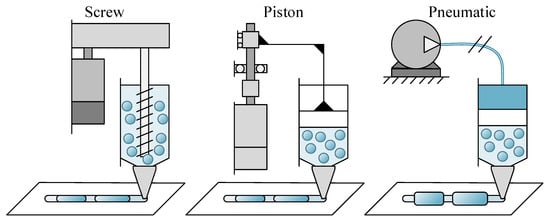
Figure 1
Open AccessArticle
Identification and Fuzzy Control of the Trajectory of a Parallel Robot: Application to Medical Rehabilitation
by
Elihu H. Ramirez-Dominguez, José G. Benítez-Morales, Jesus E. Cervantes-Reyes, Ma. de los Angeles Alamilla-Daniel, Angel R. Licona-Rodríguez, Juan M. Xicoténcatl-Pérez and Julio Cesar Ramos-Fernández
Actuators 2025, 14(10), 495; https://doi.org/10.3390/act14100495 - 13 Oct 2025
Abstract
A specific challenge in robotic control applications is the identification and regulation of actuators that provide mechanical traction and motion to the robot links. The design of actuator control laws, grounded in parametric identification and experimental motor characterization, enables numerical simulations to explore
[...] Read more.
A specific challenge in robotic control applications is the identification and regulation of actuators that provide mechanical traction and motion to the robot links. The design of actuator control laws, grounded in parametric identification and experimental motor characterization, enables numerical simulations to explore diverse operating scenarios. This article presents the initial phases in the development of a robotic rehabilitation system, focused on the kinematic modeling of a parallelogram-configuration robot for upper-limb therapy, the fuzzy identification of its actuators, and their closed-loop evaluation using a fuzzy Parallel Distributed Compensation (PDC) controller with state feedback (Ackermann), whose poles are optimized via the Grey Wolf Optimizer (GWO) metaheuristic. This controller was selected for its congruence with the nonlinear universe of discourse defined by the identified model, a key feature for operation within specific functional ranges in medical applications. The simulation and hardware platform results provide evidence that fuzzy dynamic models constitute a valuable tool for application in rehabilitation systems. This work serves as a foundation for future physical implementations with the fully coupled robotic system, in order to ensure operational safety prior to the start of clinical trials.
Full article
(This article belongs to the Special Issue Actuators and Robotic Devices for Rehabilitation and Assistance—2nd Edition)
►▼
Show Figures

Figure 1
Open AccessArticle
Quadratic Programming Vision-Based Control of a Scale-Model Autonomous Vehicle Navigating in Intersections
by
Esmeralda Enriqueta Mascota Muñoz, Oscar González Miranda, Xchel Ramos Soto, Juan Manuel Ibarra Zannatha and Santos Miguel Orozco Soto
Actuators 2025, 14(10), 494; https://doi.org/10.3390/act14100494 - 12 Oct 2025
Abstract
This paper presents an optimal control for autonomous vehicles navigating in intersection scenarios. The proposed controller is based on solving a Quadratic Programming optimization technique to provide a feasible control signal respecting actuator constraints. The proposed controller was implemented in a scale-sized vehicle
[...] Read more.
This paper presents an optimal control for autonomous vehicles navigating in intersection scenarios. The proposed controller is based on solving a Quadratic Programming optimization technique to provide a feasible control signal respecting actuator constraints. The proposed controller was implemented in a scale-sized vehicle and is executed using only on-board perception and computing systems to retrieve the state dynamics, i.e., an inertial measurement unit and a monocular camera, to compute the estimated states through intelligent computer vision algorithms. The stability of the error signals of the closed-loop system was proved both mathematically and experimentally, using standard performance indices for ten trials. The proposed technique was compared against LQR and MPC strategies, showing 67% greater accuracy than the LQR approach and 53.9% greater accuracy than the MPC technique, while turning during the intersection. Moreover, the proposed QP controller showed significantly greater efficiency by reducing the control effort by 63.3% compared to the LQR, and by a substantial 78.4% compared to the MPC. These successful results proved that the proposed controller is an effective alternative for autonomously navigating within intersection scenarios.
Full article
(This article belongs to the Special Issue Nonlinear Control of Mechanical and Robotic Systems)
►▼
Show Figures

Figure 1
Open AccessArticle
FVSMPC: Fuzzy Adaptive Virtual Steering Coefficient Model Predictive Control for Differential Tracked Robot Trajectory Tracking
by
Pu Zhang, Xiubo Xia, Yongling Fu and Jian Sun
Actuators 2025, 14(10), 493; https://doi.org/10.3390/act14100493 - 12 Oct 2025
Abstract
Differential tracked robots play a crucial role in various modernized work scenarios such as smart industry, agriculture, and transportation. However, these robots frequently encounter substantial challenges in trajectory tracking, attributable to substantial initial errors and dynamic environments, which result in slow convergence rates,
[...] Read more.
Differential tracked robots play a crucial role in various modernized work scenarios such as smart industry, agriculture, and transportation. However, these robots frequently encounter substantial challenges in trajectory tracking, attributable to substantial initial errors and dynamic environments, which result in slow convergence rates, cumulative errors, and diminished tracking precision. To address these challenges, this paper proposes a fuzzy adaptive virtual steering coefficient model predictive control (FVSMPC) algorithm. The FVSMPC algorithm introduces a virtual steering coefficient into the robot’s kinematic model, which is adaptively adjusted using fuzzy logic based on real-time positional error and velocity. This approach not only enhances the robot’s ability to quickly correct large errors but also maintains stability during tracking.The nonlinear kinematic model undergoes linearization via a Taylor expansion and is subsequently formulated as a quadratic programming problem to facilitate efficient iterative solutions. To validate the proposed control algorithm, a simulation environment was constructed and deployed on a real prototype for testing. Results demonstrate that compared to the baseline algorithm, the proposed algorithm performs excellently in trajectory tracking tasks, avoids complex parameter tuning, and exhibits high accuracy, fast convergence, and good stability. This work provides a practical and effective solution for improving the trajectory tracking performance of differential tracked robots in complex environments.
Full article
(This article belongs to the Special Issue Modeling, Perception and Control of Robotic Systems with Real-World Applications)
►▼
Show Figures

Figure 1
Open AccessArticle
RM-Act: A Novel Modular Harmonic Actuator
by
Ramesh Krishnan Muttathil Gopanunni, Alok Ranjan, Lorenzo Martignetti, Franco Angelini and Manolo Garabini
Actuators 2025, 14(10), 492; https://doi.org/10.3390/act14100492 - 11 Oct 2025
Abstract
In modern robotics, actuators are crucial for achieving effective movement and ensuring robustness. Although different applications demand specific actuator qualities, an actuator with built-in compliance and high torque density is generally preferred. Recently, harmonic gearboxes have become widely used in robotics for actuation
[...] Read more.
In modern robotics, actuators are crucial for achieving effective movement and ensuring robustness. Although different applications demand specific actuator qualities, an actuator with built-in compliance and high torque density is generally preferred. Recently, harmonic gearboxes have become widely used in robotics for actuation due to their zero-backlash, lightweight design, flexibility, and high torque density. However, the intricate and precise machining required for these gearboxes makes them economically unviable in some cases. This work presents the RM-Act, a novel Radial Modular Actuator that employs synchronous belts as a harmonic speed reducer. The RM-Act retains the advantages of the harmonic principle, making it a promising candidate for robotic actuation. This paper describes the novel actuation principle and its validation through a prototype, along with a model identification to define its characteristics. The actuator demonstrates a nominal torque density of 10.08 N·m/kg, indicating its potential for efficient robotic applications.
Full article
(This article belongs to the Special Issue Actuation and Sensing of Intelligent Soft Robots)
►▼
Show Figures

Figure 1
Open AccessArticle
Depth Control of Variable Buoyancy Systems: A Low Energy Approach Using a VSC with a Variable-Amplitude Law
by
João Bravo Pinto, João Falcão Carneiro, Fernando Gomes de Almeida and Nuno A. Cruz
Actuators 2025, 14(10), 491; https://doi.org/10.3390/act14100491 - 11 Oct 2025
Abstract
Underwater exploration relies heavily on autonomous underwater vehicles and sensor platforms for sustained monitoring of marine environments, yet their operational duration is limited by energy constraints. To enhance energy efficiency, various control strategies have been proposed, including robust, optimal, and disturbance-aware approaches. Recent
[...] Read more.
Underwater exploration relies heavily on autonomous underwater vehicles and sensor platforms for sustained monitoring of marine environments, yet their operational duration is limited by energy constraints. To enhance energy efficiency, various control strategies have been proposed, including robust, optimal, and disturbance-aware approaches. Recent work introduced a variable structure controller (VSC) with a constant-amplitude control action for depth control of a platform equipped with a variable buoyancy module, achieving an average 22% reduction in energy use in comparison with conventional PID-based controllers. In a separate paper, the conditions for its closed-loop stability were proven. This study extends these works by proposing a controller with a variable-amplitude control action designed to minimize energy consumption. A formal proof of stability is provided to guarantee safe operation even under conservative assumptions. The controller is applied to a previously developed depth-regulated sensor platform using a validated physical model. Additionally, this study analyzes how the controller parameters and mission requirements affect stability regions, offering practical guidelines for parameter tuning. A method to estimate oscillation amplitude during hovering tasks is also introduced. Simulation trials validate the proposed approach, showing energy savings of up to 16% when compared to the controller using a constant-amplitude control action.
Full article
(This article belongs to the Special Issue Advanced Underwater Robotics)
►▼
Show Figures

Figure 1
Open AccessArticle
FPI-Based Adaptive Control with Simultaneous Noise Filtering and Low Frequency Delay
by
Bence Varga, Richárd Horváth and József Kázmér Tar
Actuators 2025, 14(10), 490; https://doi.org/10.3390/act14100490 - 9 Oct 2025
Abstract
In the field of life sciences, delay effects are often modeled with two compartments that do not model any particular organ. In this paper the use of this double counterpart model is investigated in Fixed-Point Iteration-based (FPI) Control, which was introduced in 2009
[...] Read more.
In the field of life sciences, delay effects are often modeled with two compartments that do not model any particular organ. In this paper the use of this double counterpart model is investigated in Fixed-Point Iteration-based (FPI) Control, which was introduced in 2009 as an adaptive extension to the Computed Torque Control method. This controller is particularly sensitive to delays and measurement noise due to its iterative nature. It was recognized that, besides modeling the delay effect, this signal tackling also provided the controller with some noise filtering ability; the formerly accumulated effects of noise filtering and formally delayed sampling were avoided. This smeared delay has a noticeable effect even slightly later in time, making the adaptive method based on it more robust. This assumption was investigated both on a simulation and experimental basis.
Full article
(This article belongs to the Section Control Systems)
►▼
Show Figures
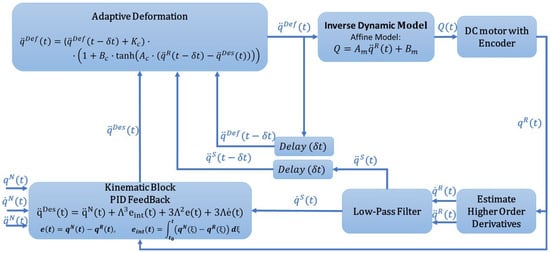
Figure 1
Open AccessArticle
Analytical Modeling and Simulation of Machinery Containing Hydraulic Lines with Fluid Transients
by
David Hullender
Actuators 2025, 14(10), 489; https://doi.org/10.3390/act14100489 - 9 Oct 2025
Abstract
In industrial equipment containing hydraulic lines for power transmission, the lines have boundary conditions defined by components such as pumps, valves, and actuators located at the ends of the lines. Sudden changes in any of the boundary conditions may result in significant pressure/flow
[...] Read more.
In industrial equipment containing hydraulic lines for power transmission, the lines have boundary conditions defined by components such as pumps, valves, and actuators located at the ends of the lines. Sudden changes in any of the boundary conditions may result in significant pressure/flow dynamics (fluid transients) in the lines that may be detrimental or favorable to the performance of the equipment. Accurate models for line transients are defined by the exact solution to a set of simultaneous partial differential equations. In this paper, analytical solutions to the partial differential equations provide Laplace transform transfer functions applicable to any set of boundary conditions yet to be specified that satisfy the requirements of causality. Analytical solutions of these partial differential equations from previous publications are reviewed for cases of laminar and turbulent flow for Newtonian and a class of non-Newtonian fluids. This paper focuses on a method for obtaining total system analytical models and time domain solutions for cases in which the end-of-line components can be modeled with linear equations for perturbations relative to pre-transient flow conditions. Examples with pumps, valves, and actuators demonstrate the process of coupling equations for components at the ends of a line to obtain total system transfer functions and then obtain time domain solutions for outputs of interest associated with system inputs and load variations.
Full article
(This article belongs to the Special Issue Advances in Fluid Power Systems and Actuators)
►▼
Show Figures

Figure 1

Journal Menu
► ▼ Journal Menu-
- Actuators Home
- Aims & Scope
- Editorial Board
- Reviewer Board
- Topical Advisory Panel
- Instructions for Authors
- Special Issues
- Topics
- Sections
- Article Processing Charge
- Indexing & Archiving
- Editor’s Choice Articles
- Most Cited & Viewed
- Journal Statistics
- Journal History
- Journal Awards
- Conferences
- Editorial Office
Journal Browser
► ▼ Journal BrowserHighly Accessed Articles
Latest Books
E-Mail Alert
News
Topics
Topic in
Actuators, Algorithms, BDCC, Future Internet, JMMP, Machines, Robotics, Systems
Smart Product Design and Manufacturing on Industrial Internet
Topic Editors: Pingyu Jiang, Jihong Liu, Ying Liu, Jihong YanDeadline: 31 December 2025
Topic in
Actuators, Automation, Electronics, Machines, Robotics, Eng, Technologies
New Trends in Robotics: Automation and Autonomous Systems
Topic Editors: Maki Habib, Fusaomi NagataDeadline: 31 January 2026
Topic in
Actuators, Gels, JFB, Polymers, MCA, Materials
Recent Advances in Smart Soft Materials: From Theory to Practice
Topic Editors: Lorenzo Bonetti, Giulia Scalet, Silvia Farè, Nicola FerroDeadline: 31 December 2026

Conferences
Special Issues
Special Issue in
Actuators
Modeling, Dynamics, Intelligent Control, and Fault Diagnosis of Vehicle Systems—2nd Edition
Guest Editors: Yongjun Pan, Weicheng HuangDeadline: 20 October 2025
Special Issue in
Actuators
Intelligent Sensing, Control and Actuation in Networked Systems
Guest Editors: Guangtao Ran, Yanning Guo, Chuan-jiang LiDeadline: 20 October 2025
Special Issue in
Actuators
Advances in Dynamics and Motion Control of Unmanned Aerial/Underwater/Ground Vehicles—2nd Edition
Guest Editor: Han Sol KimDeadline: 20 October 2025
Special Issue in
Actuators
Advanced Robots: Design, Control and Application—3rd Edition
Guest Editor: Ioan DorofteiDeadline: 31 October 2025











